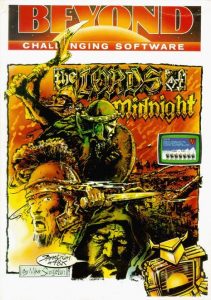621th played so far
Genre: Strategy/Adventure
Platform: ZX Spectrum
Year of Release: 1984
Developer: Mike Singleton
Publisher: Beyond Software
I sort of remember Lords of Midnight. I was a lot younger, but cousins had it on an old computer system and we (sort of) used to try it. I’m not sure I ever understood quite what it was about, but they probably got into it. Most important was that it looked and felt different, a game where you went out on an adventure and no platforming was required. Instead you got these blocky knights standing in this world.
Our Thoughts
Before starting Lords of Midnight, it felt like a good idea to read up on strategies and how things worked. An old strategy game usually doesn’t communicate its best routes that well and I really didn’t want to get lost with this game. While this paid off – I managed to play for quite a while – it meant that I had a bunch of false starts as I figured out the control and direction to go in. Not too frustrating, but at times confusing.
Often, when a game is listed here with two genres, it’s either because it combines both or, in the case of action/adventures in particular, because they’re their own sub genre. Here, however, you are playing two games that overlap and mix, but where you only need to play one to win – although using both can help a lot.
The adventure game is somewhat Lord of the Rings like – sneak into a mountain fort to destroy an artifact. It’s a simple light RPG thing that’s not as deep as proper entries in the genre, but is quite difficult with the armies and monsters roaming the map and the character who needs to do so generally not being as strong.
The strategy game isn’t complex either – you recruit armies and generals who need them, strengthen them and go around until you are strong enough to assault the main base and take out the big bad.
The big epic mode is of course to do both, as a two pronged attack that, again, sounds a bit like the Lord of the Rings plot.
You have a group of protagonists who help you through – four starting off, although you recruit more generals. The first, Morkin, is the adventurer who is the protagonist of the adventure strand. His father, Luxor, is the great general who leads the army to success. Two others can move around as well, with Rothron being good at recruiting further armies. It feels like there is a nice bit of differentiation between them that adds character to it.
A last element that stands out are the graphics. What’s quite amazing for the time is that it doesn’t show a set image, based on your immediate surroundings, but that it shows elements several squares away (depending on what would be blocking it). They’re not full 3D effects, but add enough depth to create more of a sense of place and especially scale.
Final Thoughts
One of the interesting features of the game is that it feels like it was one of the first that gave you options. There are two ways of winning the game, and while they support each other, if you focus on one you can manage. It makes for an interesting path, one that is still interesting today and that I could see work with a cleaned up interface.
